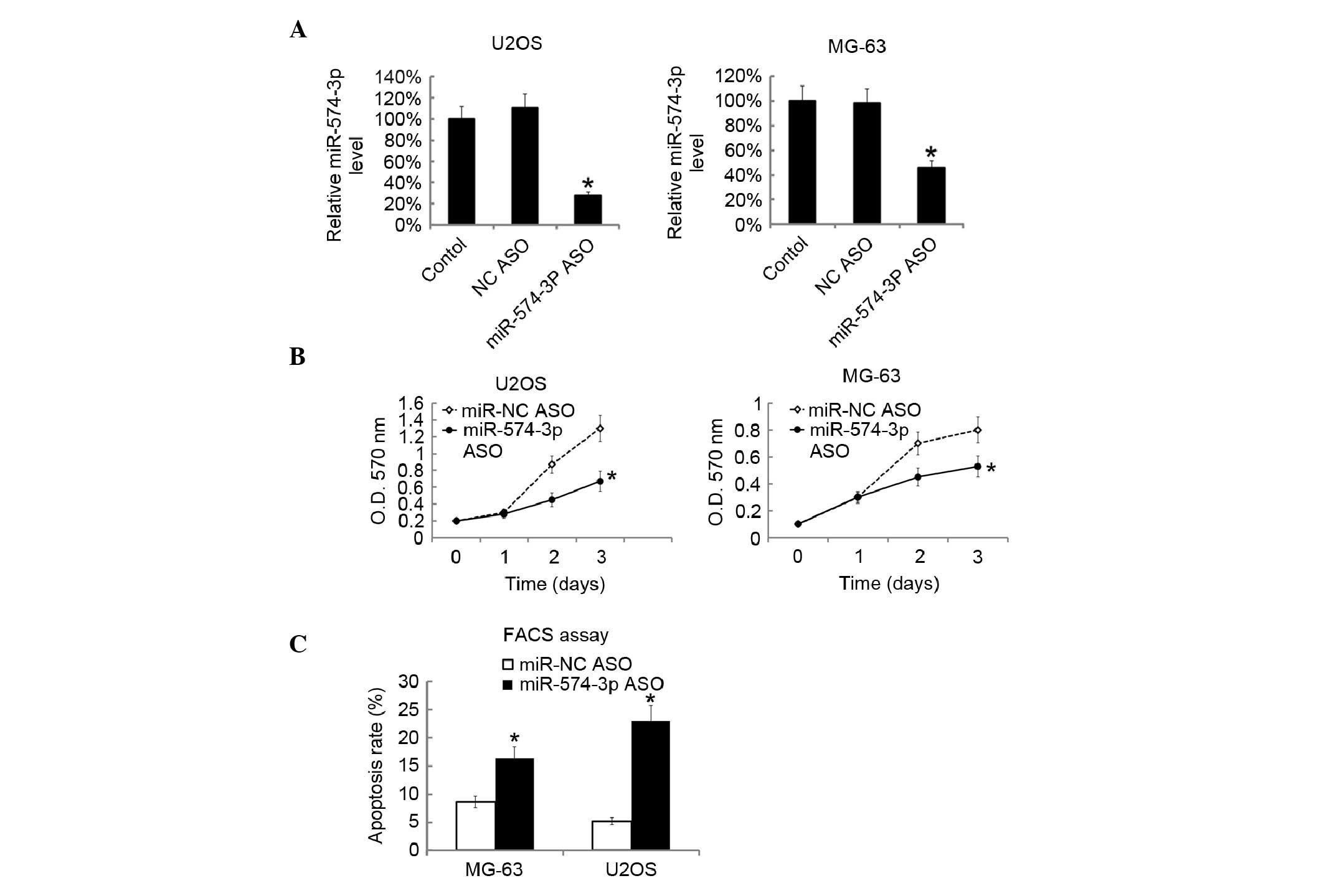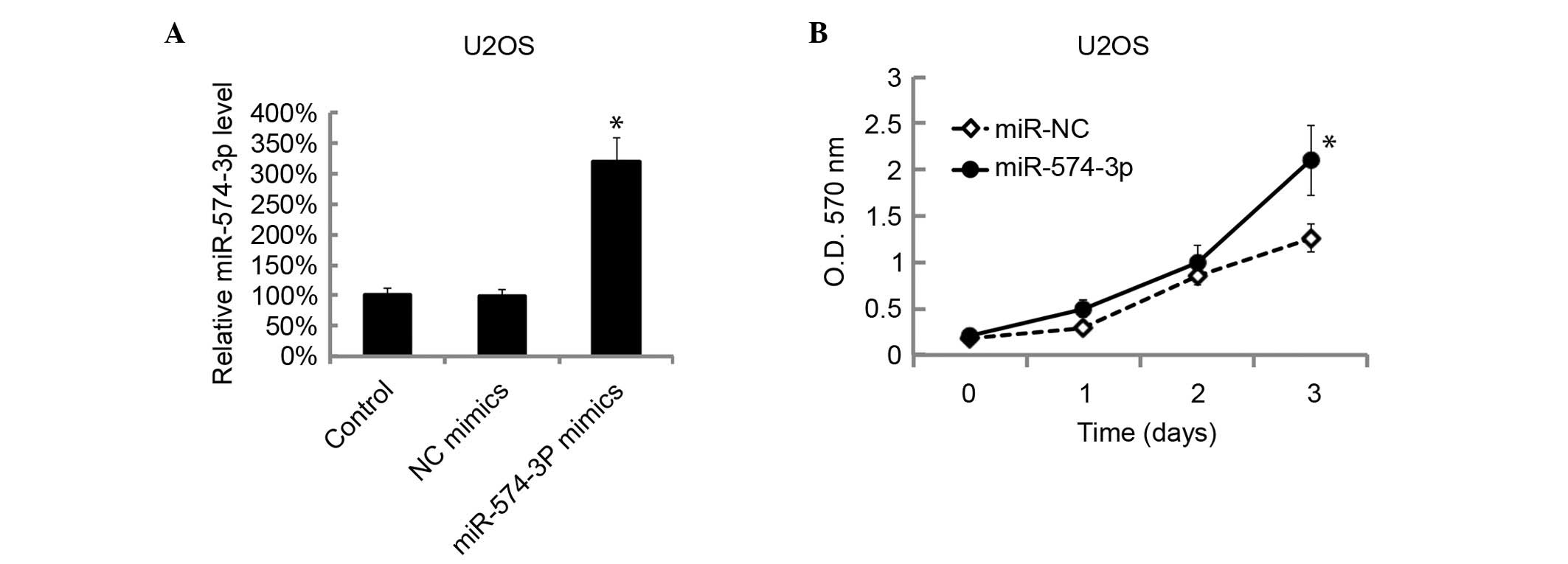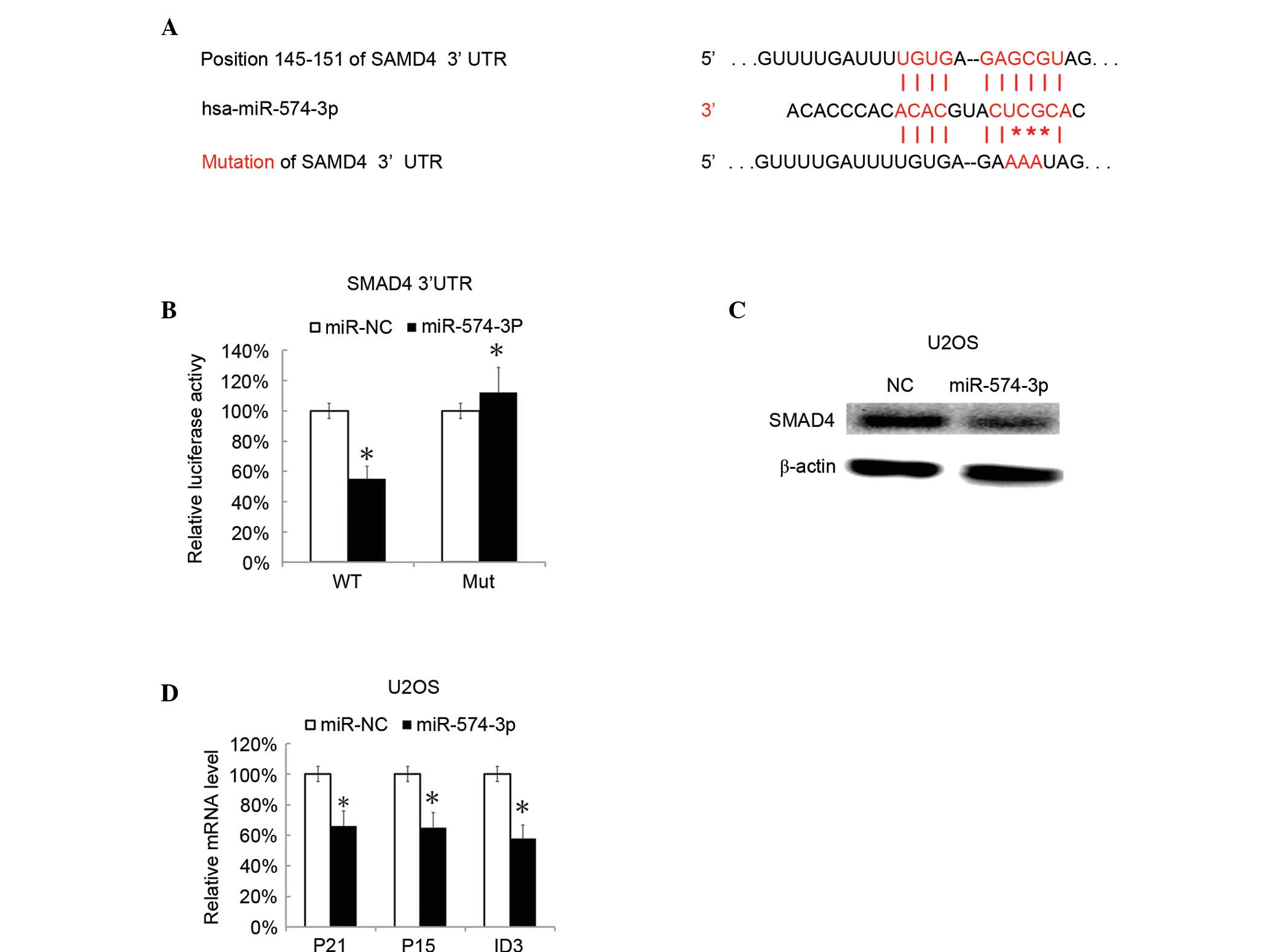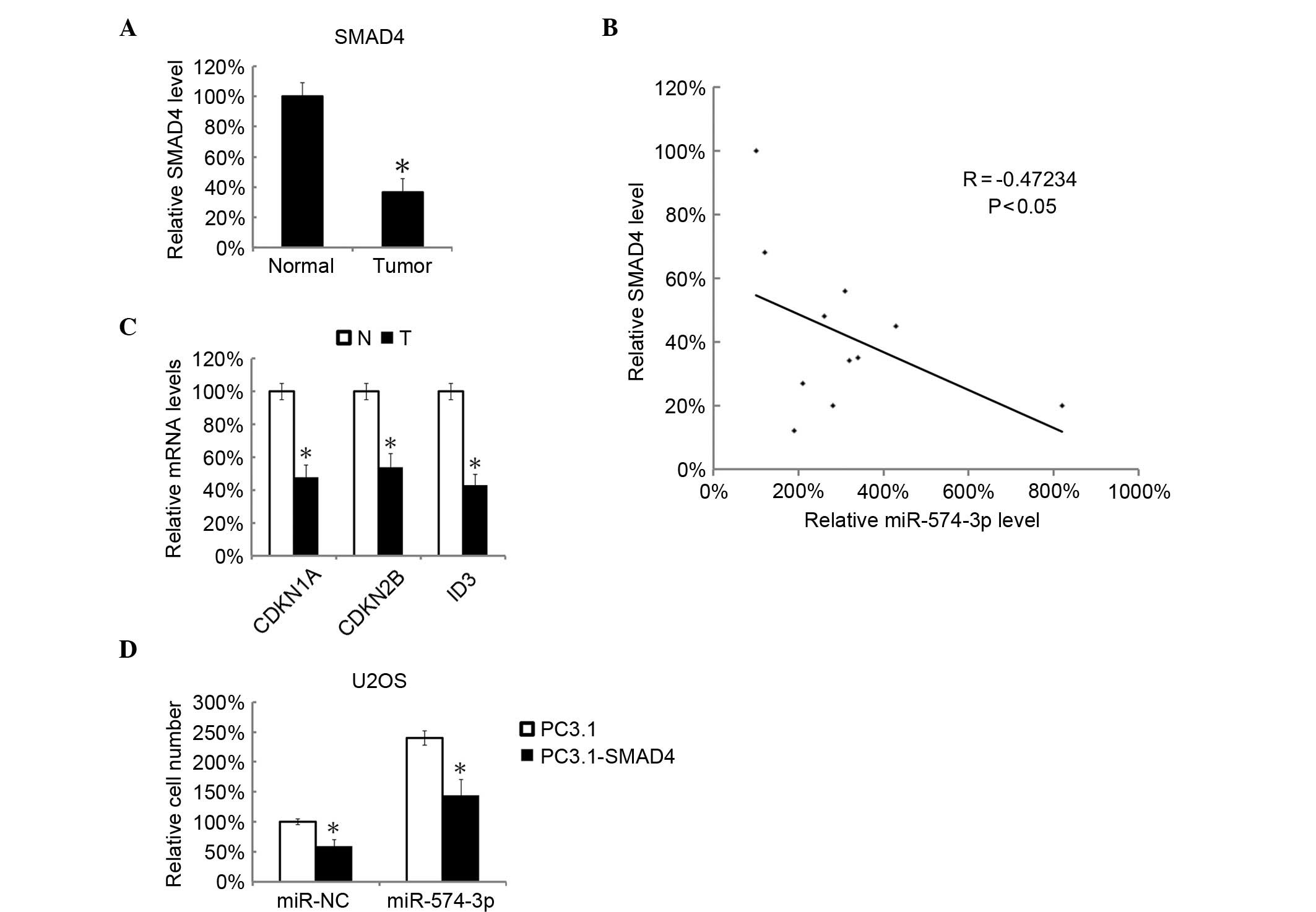miR-574-3p acts as a tumor promoter in osteosarcoma by targeting SMAD4 signaling pathway
- Authors:
- Published online on: November 7, 2016 https://doi.org/10.3892/ol.2016.5355
- Pages: 5247-5253
Abstract
Introduction
Human osteosarcoma is the most common primary bone malignancy sarcoma found primarily in children and young people (1–3). The patients with osteosarcoma exhibit severe clinical manifestations, significantly diminished mobility and a reduced life expectancy (4,5). However, the prognosis remained poor. It is important to clarify the underlying mechanism so that safe and effective therapeutic strategies may be developed.
MicroRNA (miRNA) is a class of small non-coding RNA, with lengths of 18–22 nucleotides; they play important roles in numerous biological processes through transcriptional suppression of target genes (6–8). The critical functions of numerous miRNAs in cancer biology have been illustrated, including the regulation of various cellular processes, such as proliferation and apoptosis (3,5,9,10). The abnormality of miR-574-3p was observed in patients with non-small cell lung cancer and prostate cancer, and it was found that this miRNA regulated colorectal cancer growth and plays important roles in bladder cancer cell lines (11–13). Nevertheless, whether miR-574-3p participates in the progression of osteosarcoma remains unclear. In the present study, it was demonstrated that the level of miR-574-3p was significantly higher in the human osteosarcoma tissues and cell lines and miR-574-3p also regulated osteosarcoma cell growth through targeting the mothers against decapentaplegic homolog 4 (SMAD4) signaling pathway.
Materials and methods
Patients
Surgical specimens from 10 osteosarcoma and matched normal control tissues were obtained postoperatively in May 2010 from the Department of Orthopedics of Jinling Hospital, Nanjing University, School of Medicine (Nanjing, China) (3,5,10). All patients provided signed informed consent for their tissues to be used for scientific research. Ethical approval for the study was obtained from Jinling Hospital, Nanjing University. All diagnoses were based on pathological and/or cytological evidence (10). The histological features of the specimens were evaluated by senior pathologists according to the World Health Organization classification criteria (11–13). Tissues were obtained prior to chemotherapy and radiotherapy, and were immediately frozen and stored at −80°C prior to reverse-transcription quantitative polymerase chain reaction (RT-qPCR) assay (3,5,10).
Cell lines, cell culture and transfection
Human osteosarcoma U2OS, SAOS and MG63 cell lines, and the normal human osteoblast cell line were obtained from Jinling Hospital Affiliated to Nanjing University (Nanjing, China), and maintained in Dulbecco's Modified Eagle's medium supplemented with 10% fetal bovine serum (GE Healthcare Bio-Sciences- Pittsburgh, PA, USA) (10). U2OS and MG63 cells were seeded in 24-well plates at a density of 6×104 cells per well and transfected with antisense (ASO)-miR574, mimics (Shanghai GenePharma Co., Ltd., Shanghai, China) or pcDNA3.1-SMAD4 at a concentration of 50 nM using Lipofectamine 2000 (Invitrogen; Thermo Fisher Scientific, Inc., Pittsburgh, PA, USA) according to the manufacturer's protocol. Subsequent to 48 h, cells were used for additional experiments (3).
RNA extraction and RT-qPCR
RNA from tumor tissues of differently treated groups were homogenized in TRIzol (Invitrogen; Thermo Fisher Scientific, Inc.) and isolated according to the manufacturer's protocol. RT-qPCR was assessed using the miScript RT Kit and miScript PCR system (both Qiagen China Co., Ltd., Shanghai, China) according to the manufacturer's protocol, during which glyceraldehyde 3-phosphate dehydrogenase was used as an internal control (3). The thermocycling conditions for the PCR were was as follows: 95°C for 15 min; 40 cycles of 94°C for 15 sec, 55°C for 30 sec and 70°C for 30 sec; and 95°C for 1 min (3–5). Data were normalized using the 2−ΔΔCq method, whereby the cycle threshold (Cq) for the gene of interest was compared with the Cq of the internal control gene (14).
Western blot assay
Cells were homogenized in Mammalian Protein Extraction reagent containing a Halt Protease Inhibitor Cocktail (both Thermo Fisher Scientific, Inc.), 150 mM NaCl and 1 mM EDTA. The lysates were mixed with an equal volume of sample buffer (cat. no. P0015B; Beyotime Institute of Biotechnology, Haimen, China) and proteins were subsequently denatured by boiling. Protein quantification was performed using an Enhanced BCA Protein Assay kit (cat. no. P0010S; Beyotime Institute of Biotechnology). A total of 20 µg protein was loaded into each lane. Total protein was separated using SDS-PAGE on a 10% gel (3). The proteins were transferred onto nitrocellulose membranes (GE Healthcare Life Sciences, Chalfont, UK), blocked with 5% milk and incubated overnight at 4°C with the primary antibody anti-SMAD4 (1:1,500; cat. no. ab40759; Abcam, Cambridge, UK); β-actin was used as the loading control (anti-β-actin; 1:13,000; cat. no. ab8227; Abcam). The blots were then incubated with the anti-rabbit immunoglobulin G horseradish peroxidase-conjugated secondary antibody (1:10,000; cat. no. ab7090; Abcam) for 1 h at room temperature. Immunoreactivity was detected using the ImageQuant™ LAS-4000 Luminescent Image Analyzer (GE Healthcare Life Sciences). Protein bands were quantified by means of densitometry using Fuji Image Gauge software (version 4.0; Fujifilm) as previously described (3).
Proliferation assay
Cells were seeded into 96-well plates at a density of 4,000 cells per well and transfected with miR-574-3p/negative control/pcDNA3.1-SMAD4 (3,5,10). Cell viability was determined by methyl thiazolyl tetrazolium (MTT) assay to detect the viable proliferating cells at different time points subsequent to transfection (3). The MTT Cell Proliferation and Cytotoxicity assay kit (Amresco, LLC, Solon, OH, USA) was used. Following photosensitization, 100 µg MTT in 20 µl PBS was added to each well at 0, 24, 48 and 72 h and plates were subsequently incubated at 37°C for 3 h. The reaction was stopped by the addition of 180 µl dimethyl sulfoxide. The optical density (OD) of each sample was subsequently measured at a wavelength of 490 nm using a microplate spectrophotometer (Thermo 3001; Thermo Fisher Scientific, Inc.). Cell survival rate (%) was calculated as the following: (ODtreated / ODcontrol) × 100.
Apoptosis assay
Following transfection of the U2OS and MG-63 cells with the miR-574-3p ASO, miR-574-3p mimics or controls. Cell apoptosis was determined using apoptosis detection kit (Beyotime Institute of Biotechnology) according to the manufacturer's protocol (3,5,10). Samples were determined by flow cytometry assays and the results were analyzed using Cell-Quest software (version 7.5.3; Becton Dickinson, San Jose, CA, USA).
miRNA target prediction and luciferase assay
miRNA targets were predicted using the TargetScan algorithms (http://www.targetscan.org). The SMAD4-luciferase-3′-untranslated region (UTR) reporter was generated by inserting the full length SMAD4 3′-UTR into pGL3 promoter vector (Promega Corporation, Madison, WI, USA) as previously reported (3). Luciferase assays were performed using NIH3T3 cells, as previously described (15). Cells were transfected with appropriate plasmids [TK Renilla luciferase (RL) plasmids, wild type or mutated SMAD4 3′-UTR pGL3 promoter vector, synthetic miR mimics/inhibitors (ASO oligo) with scramble control] in 24-well plates. Cells were lysed for the luciferase assay 48 h subsequent to transfection. Luciferase assays were conducted by using a luciferase assay kit (E1910; Promega Corporation) according to the manufacturer's protocol (3,5,10).
Statistical analysis
The data was expressed as the mean ± standard deviation. Student's t-test was used for comparisons between experimental groups and relevant controls (3,5). The difference between groups was analyzed using one-way analysis of variance when ≥3 groups were compared. P<0.05 was considered to indicate a statistically significant difference. The correlation between SMAD4 protein and miR-574-3p expression levels was assessed by Spearman's rank correlation coefficient analysis.
Results
miR-574 level was elevated in human osteosarcoma tissues
Initially, the present study assessed the levels of miR-574-3p in U2OS, SAOS2 and MG63 osteosarcoma cell lines by RT-qPCR; the miR-574-3p level in osteoblast cells was used as a control. It was found that the expression levels of miR-574-3p in the 3 osteosarcoma cell lines were significantly higher than that in osteoblast cells (P=0.0023; Fig. 1A). The miR-574-3p levels in 10 pairs of human osteosarcoma tissues and the matched tumor adjacent normal tissues were assayed by RT-qPCR. It was found that osteosarcoma tissues showed a significantly higher level of miR-574-3p than the matched tumor-adjacent normal tissues in all 10 pairs (P=0.0089; Fig. 1B).
Downregulation of miR-574-3p inhibited cell growth and induced cell apoptosis
To investigate the effects of miR-574-3p on osteosarcoma cells, miR-574-3p levels were inhibited in U2OS and MG-63 cells by transfecting the cells with miR-574-3p ASO. The miR-574-3p levels in cells were assessed by RT-qPCR 48 h subsequent to transfection. It was found that miR-574-3p ASO significantly inhibited the miR-574-3p levels in the two cell lines (P=0.0073; Fig. 2A). Following transfection, cellular proliferation was then assessed by MTT analysis. The data suggested that knockdown of miR-574-3p significantly inhibited the growth of U2OS and MG63 cells (P=0.0102; Fig. 2B). Fluorescence-activated cell sorting (FACS) analysis showed that the inhibition of miR-574-3p induced cell apoptosis in MG63 and U2OS cells (Fig. 2C).
Overexpression of miR-574-3p promoted cells growth
The level of miR-574-3p levels in U2OS cells was overexpressed by transfection of miR-574-3p mimics. The miR-574-3p levels in U2OS cells were assessed by RT-qPCR 48 h after transfection. The miR-574-3p level in U2OS cells was significantly overexpressed by miR-574-3p transfection with mimics (P=0.0093; Fig. 3A). The cellular proliferation was then examined by MTT analysis following miR-574-3p mimic transfection. The overexpression of miR-574-3p significantly promoted the cellular proliferation of U2OS (P=0.0115; Fig. 3B).
miR-574-3p directly targets the SMAD4 signaling pathway
To identify the potential targeted genes, SMAD4 was predicted as a target gene of miR-574-3p by using TargetScan. SMAD4 is a unique common effector of tumor growth factor-β (TGF-β) and bone morphogenetic protein signal pathways (16). SMAD4 is frequently mutated in human carcinomas, leading to loss of growth inhibition by TGF-β (17). Thus, SMAD4 was chosen for additional investigation. The 3′untranslated region (3′-UTR) and mutant 3′-UTR of SMAD4 were used for the identification of target gene of miR-574-3p (Fig. 4A). It was found that miR-574-3p could markedly decrease the luciferase activity in SMAD4 3′-UTR transfected cells while not in the mutant-transfected cells (Fig. 4B). U2OS cells were then transfected with miR-574-3p mimics. SMAD4 protein level was then assessed by western blotting after 48 h. It was found that SMAD4 expression was also significantly inhibited in miR-574-3p-expressing cells (P=0.0079; Fig. 4C). Cyclin-dependent kinase inhibitor 1 (CDKN1A), cyclin dependent kinase 4 inhibitor B (CDKN2B) and inhibitor of DNA binding (ID3) are the SMAD4-dependent genes (18). The present data showed that CDKN1A, CDKN2B and ID3 were also significantly repressed in U2OS cells by transfection with miR-574-3p mimics compared with the negative control miRNA-transfected cells (P=0.0068; Fig. 4D).
Overexpression of SMAD4 attenuated the tumor promoting effects of miR-574-3p
The SMAD4 levels were investigated in osteosarcoma tissues by RT-qPCR. It was found that osteosarcoma tissues showed significantly decreased SMAD4 mRNA expression compared with adjacent normal tissues (P=0.0058; Fig. 5A). Subsequently, the miR-574-3p levels and the SMAD4 levels in 10 osteosarcoma tissue samples were analyzed, and it was found that the miR-574-3p levels and the SMAD4 levels were negatively correlated (Fig. 5B). By RT-qPCR, the expression of SMAD4 target genes, CDKN1A, CDKN2B and ID2, were also significantly decreased in osteosarcoma tissues (P=0.0093; Fig. 5C). U2OS cell were co-transfected with SMAD4 overexpression plasmid, pc3.1-SMAD4 and miR-574-3p mimics. The cell growth was evaluated by MTT analysis 48 h later. It was found that that the tumor-promoting effect of miR-574-3p was significantly inhibited by overexpression of SMAD4 (P=0.0124; Fig. 5D).
Discussion
miR-574 has been found to be upregulated in several types of cancers, including lung cancer, bladder cancer and prostate cancer (11–13,19). Foss et al (17) also suggested miR-574 as a serum biomarker of non-small cell lung cancer. miR-574-3p negatively regulates Quaking 6/7 (Qki6/7), thus affecting β-catenin/wingless (Wnt) signaling and the development of colorectal cancer (12). Furthermore, miR-574-3p was associated with various human cancers (19,20). In the present study, it was demonstrated that miR-574-3p was downregulated in human osteosarcoma tissues as well as osteosarcoma U2OS, SAOS and MG63 cell lines. Inhibition of miR-574-3p by ASO attenuated cell proliferation and resulted in the apoptosis in osteosarcoma cells, while miR-574-3p mimics promoted the growth of U2OS cells. Subsequently, SMAD4 was identified as a target of miR-574-3p. SMAD4 overexpression could rescue the promoting effects of miR-574-3p on cancer cell growth, which additionally supports the theory that miR-574-3p may be associated with SMAD4.
miRNAs are critical regulators and biomarkers for numerous types of cancers (8,21–24). There are several miRNAs that have been found to be abnormal in human osteosarcoma, including miR-141, miR-429, miR-451, miR-195, miR-183 miR-199a-3p, miR-127-3p and miR-376c (3,5,10,25–27). In the present study, it was reported that miR-574-3p was highly expressed in human osteosarcoma cells lines and tissues, and it was indicated that miR-574-3p may be used as a biomarker for the diagnosis of osteosarcoma.
The present study observed that miR-574-3p is closely and positively associated with the proliferation of osteosarcoma cells. Downregulation of miR-574-3p suppressed the growth of U2OS cells and MG63 cells with the induction of apoptosis, while overexpression of miR-574-3p enhanced the growth of these cells. These data indicated that miR-574-3p plays an oncogene-like function in osteosarcoma development. It has been also reported that miR-574-3p targets Qki6/7 and affects colorectal cancer through acting on the Wnt signaling pathway (12). In the present study, it was suggested that SMAD4 is a direct target of miR-574-3p and the associated genes CDKN1A, CDKN2B as well as ID3 were strongly suppressed by miR-574-3p transfection. SMAD4 is often mutated in numerous cancers and it acts as a tumor suppressor that is involved in the regulation of the TGF-β signal transduction pathway, which negatively regulates growth of epithelial cells and the extracellular matrix (28–31). Therefore, the inhibition of SMAD4 and its downstream proteins may be an important part of the mechanism of miR-574-3p in osteosarcoma.
To investigate the importance of miR-574-3p-SMAD4 interaction in osteosarcoma, the current study determined the level of SMAD4 and its associated genes (CDKN1A, CDKN2B and ID2) and found that they were all decreased in osteosarcoma tissues. The expression of miR-574-3p was inversely correlated with SMAD4 expression. Notably, SMAD4 overexpression rescued the tumor-promoting effects of miR-574-3p, indicating that miR-574-3p exerted an oncogenic effect, mainly through regulating the SMAD4 signaling pathway. However, a single miRNA could modulate >100 target genes (6), and the underlying mechanism continues to require clarification in future studies.
In conclusion, the present study found that that miR-574-3p is upregulated in human osteosarcoma, and plays an oncogene-like role in human osteosarcoma through targeting the tumor-suppressing gene SMAD4 and acting on the SMAD4 signaling pathway. The current findings provide a novel target for the diagnosis and treatment of human osteosarcoma.
References
|
de Oliveira JM Ferreira, Remédios C, Oliveira H, Pinto P, Pinho F, Pinho S, Costa M and Santos C: Sulforaphane induces Dna damage and mitotic abnormalities in human osteosarcoma mg-63 cells: Correlation with cell cycle arrest and apoptosis. Nutr Cancer. 66:325–334. 2014. View Article : Google Scholar : PubMed/NCBI | |
|
Walter I, Wolfesberger B, Miller I, Mair G, Burger S, Gallè B and Steinborn R: Human osteosarcoma cells respond to sorafenib chemotherapy by downregulation of the tumor progression factors S100A4, CXCR4 and the oncogene FOS. Oncol Rep. 31:1147–1156. 2014.PubMed/NCBI | |
|
Xu H, Mei Q, Shi L, Lu J, Zhao J and Fu Q: Tumor-Suppressing effects of miR451 in human osteosarcoma. Cell Biochem Biophys. 69:163–168. 2014. View Article : Google Scholar : PubMed/NCBI | |
|
Li R, Zhang W, Cui J, Shui W, Yin L, Wang Y, Zhang H, Wang N, Wu N, Nan G, et al: Targeting BMP9-promoted human osteosarcoma growth by inactivation of notch signaling. Curr Cancer Drug Targets. 14:274–285. 2014. View Article : Google Scholar : PubMed/NCBI | |
|
Liu X, Liu Y, Wu S, Shi X, Li L, Zhao J and Xu H: Tumor-suppressing effects of mir-429 on human osteosarcoma. Cell Biochem Biophys. 70:215–224. 2014. View Article : Google Scholar : PubMed/NCBI | |
|
Chu Y, Zhu H, Lv L, Zhou Y and Huo J: MiRNA s in oesophageal squamous cancer. Neth J Med. 71:69–75. 2013.PubMed/NCBI | |
|
Lai X, Wolkenhauer O and Vera J: Modeling miRNA regulation in cancer signaling systems: miR-34a regulation of the p53/Sirt1 signaling module. Methods Mol Biol. 880:87–108. 2012. View Article : Google Scholar : PubMed/NCBI | |
|
Mo MH, Chen L, Fu Y, Wang W and Fu SW: Cell-free circulating miRNA biomarkers in cancer. J Cancer. 3:432–448. 2012. View Article : Google Scholar : PubMed/NCBI | |
|
Ahmed FE: miRNA as markers for the diagnostic screening of colon cancer. Expert Rev Anticancer Ther. 14:463–485. 2014. View Article : Google Scholar : PubMed/NCBI | |
|
Xu H, Mei Q, Xiong C and Zhao J: Tumor-suppressing effects of miR-141 in human osteosarcoma. Cell Biochem Biophys. 69:319–325. 2014. View Article : Google Scholar : PubMed/NCBI | |
|
Xu H, Liu X and Zhao J: Down-regulation of miR-3928 promoted osteosarcoma growth. Cell Physiol Biochem. 33:1547–1556. 2014. View Article : Google Scholar : PubMed/NCBI | |
|
Liu X, Liu Y, Wu S, Shi X, Li L, Zhao J and Xu H: Tumor-suppressing effects of miR-429 on human osteosarcoma. Cell Biochem Biophys. 70:215–224. 2014. View Article : Google Scholar : PubMed/NCBI | |
|
Mei Q, Li F, Quan H, Liu Y and Xu H: Busulfan inhibits growth of human osteosarcoma through miR-200 family microRNAs in vitro and in vivo. Cancer Sci. 105:755–762. 2014. View Article : Google Scholar : PubMed/NCBI | |
|
Livak KJ and Schmittgen TD: Analysis of relative gene expression data using real-time quantitative PCR and the 2(−Delta Delta C(T)) method. Methods. 25:402–408. 2001. View Article : Google Scholar : PubMed/NCBI | |
|
Chiyomaru T, Yamamura S, Fukuhara S, Hidaka H, Majid S, Saini S, Arora S, Deng G, Shahryari V, Chang I, et al: Genistein up-regulates tumor suppressor microRNA-574-3p in prostate cancer. PLoS One. 8:e589292013. View Article : Google Scholar : PubMed/NCBI | |
|
Ji S, Ye G, Zhang J, Wang L, Wang T, Wang Z, Zhang T, Wang G, Guo Z, Luo Y, et al: miR-574-5p negatively regulates Qki6/7 to impact β-catenin/Wnt signalling and the development of colorectal cancer. Gut. 62:716–726. 2013. View Article : Google Scholar : PubMed/NCBI | |
|
Foss KM, Sima C, Ugolini D, Neri M, Allen KE and Weiss GJ: miR-1254 and miR-574-5p: Serum-based microRNA biomarkers for early-stage non-small cell lung cancer. J Thorac Oncol. 6:482–488. 2011. View Article : Google Scholar : PubMed/NCBI | |
|
Cui J, Cheng Y, Zhang P, Sun M, Gao F, Liu C and Cai J: down regulation of miR200c promotes radiation-induced thymic lymphoma by targeting BMI1. J Cell Biochem. 115:1033–1042. 2014. View Article : Google Scholar : PubMed/NCBI | |
|
Shi Y and Massagué J: Mechanisms of TGF-beta signaling from cell membrane to the nucleus. Cell. 113:685–700. 2003. View Article : Google Scholar : PubMed/NCBI | |
|
Schutte M: DPC4/SMAD4 gene alterations in human cancer, and their functional implications. Ann Oncol. 10:(Suppl 4). 56–59. 1999. View Article : Google Scholar : PubMed/NCBI | |
|
Kowanetz M, Valcourt U, Bergström R, Heldin CH and Moustakas A: Id2 and Id3 define the potency of cell proliferation and differentiation responses to transforming growth factor beta and bone morphogenetic protein. Mol Cell Biol. 24:4241–4254. 2004. View Article : Google Scholar : PubMed/NCBI | |
|
Su Y, Ni Z, Wang G, Cui J, Wei C, Wang J, Yang Q, Xu Y and Li F: Aberrant expression of microRNAs in gastric cancer and biological significance of miR-574-3p. Int Immunopharmacol. 13:468–475. 2012. View Article : Google Scholar : PubMed/NCBI | |
|
Meyers-Needham M, Ponnusamy S, Gencer S, Jiang W, Thomas RJ, Senkal CE and Ogretmen B: Concerted functions of HDAC1 and microRNA-574-5p repress alternatively spliced ceramide synthase 1 expression in human cancer cells. EMBO Mol Med. 4:78–92. 2012. View Article : Google Scholar : PubMed/NCBI | |
|
Chen Y, Sun Y, Chen L, Xu X, Zhang X, Wang B, Min L and Liu W: miRNA-200c increases the sensitivity of breast cancer cells to doxorubicin through the suppression of E-cadherin-mediated PTEN/Akt signaling. Mol Med Rep. 7:1579–1584. 2013.PubMed/NCBI | |
|
Sun D, Layer R, Mueller AC, Cichewicz MA, Negishi M, Paschal BM and Dutta A: Regulation of several androgen-induced genes through the repression of the miR-99a/let-7c/miR-125b-2 miRNA cluster in prostate cancer cells. Oncogene. 33:1448–1457. 2014. View Article : Google Scholar : PubMed/NCBI | |
|
Martin EC, Bratton MR, Zhu Y, Rhodes LV, Tilghman SL, Collins-Burow BM and Burow ME: Insulin-like growth factor-1 signaling regulates miRNA expression in MCF-7 breast cancer cell line. PLoS One. 7:e490672012. View Article : Google Scholar : PubMed/NCBI | |
|
Pignot G, Cizeron-Clairac G, Vacher S, Susini A, Tozlu S, Vieillefond A, Zerbib M, Lidereau R, Debre B, Amsellem-Ouazana D and Bieche I: microRNA expression profile in a large series of bladder tumors: Identification of a 3-miRNA signature associated with aggressiveness of muscle-invasive bladder cancer. Int J Cancer. 132:2479–2491. 2013. View Article : Google Scholar : PubMed/NCBI | |
|
Ouyang L, Liu P, Yang S, Ye S, Xu W and Liu X: A three-plasma miRNA signature serves as novel biomarkers for osteosarcoma. Med Oncol. 30:3402013. View Article : Google Scholar : PubMed/NCBI | |
|
Novello C, Pazzaglia L, Cingolani C, Conti A, Quattrini I, Manara MC, Tognon M, Picci P and Benassi MS: miRNA expression profile in human osteosarcoma: Role of miR-1 and miR-133b in proliferation and cell cycle control. Int J Oncol. 42:667–675. 2013.PubMed/NCBI | |
|
Maire G, Martin JW, Yoshimoto M, Chilton-MacNeill S, Zielenska M and Squire JA: Analysis of miRNA-gene expression-genomic profiles reveals complex mechanisms of microRNA deregulation in osteosarcoma. Cancer Genet. 204:138–146. 2011. View Article : Google Scholar : PubMed/NCBI | |
|
Xue J, Lin X, Chiu WT, Chen YH, Yu G, Liu M, Feng XH, Sawaya R, Medema RH, Hung MC and Huang S: Sustained activation of SMAD3/SMAD4 by FOXM1 promotes TGF-β-dependent cancer metastasis. J Clin Invest. 124:564–579. 2014. View Article : Google Scholar : PubMed/NCBI |














